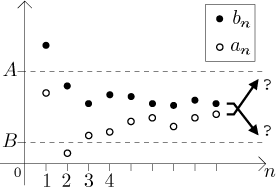
Here we explore the relationship between convergence and comparison by inequality. The main result is the Squeeze theorem.
When two convergent sequences are given, there is a connection between a term-by-term comparison and comparison of their limits:
Theorem.
Let{an} be a sequence converging to A and let{bn} be a sequence converging to B.
(i) If there is a natural number K such thatan ≤ bn for alln > K, then alsoA ≤ B.
(ii) IfA < B, then there is a natural number K such thatan < bn for alln > K.
Both statement should seem obvious when you try to draw some pictures. For
the first statement, try to imagine the opposite: that

Similarly, for the second statement you should try to draw a situation when
Note two things. First, it is not possible to make a "sharp" version
of the part (i). That is, even if terms of one sequence are sharply greater
than the other ones, say, if always
Similarly, it is not possible to make the statement in (ii) without sharp
inequalities. If we start with the assumption
Note also that we could have stated the theorem in more generality: We could
have allowed the limits A and/or B to be infinite. The theorem
would still be true, but we would not really get any extra information. For
instance, if we knew that
Note that in the theorem we assumed from the start that the two sequences are convergent. This was necessary, it is not possible to derive any conclusion about convergence by comparison. For instance, if we know that one sequence converges to 5 and another is, term-for-term, larger, we cannot say whether this new sequence is convergent as it has too much freedom (by the theorem we just know that if it were, then its limit would have to be at least 5). In order to derive convergence from comparison, one needs much more, see the Squeeze theorem below.
However, sometimes it is possible to force the existence of an improper limit from just one comparison:
Theorem.
Assume that there is a natural number K such thatan ≤ bn for alln > K.
Ifan→∞, then alsobn→∞.
Ifbn→−∞, then alsoan→−∞.
The picture should convince you that the first statement is true; the second is equally obvious.
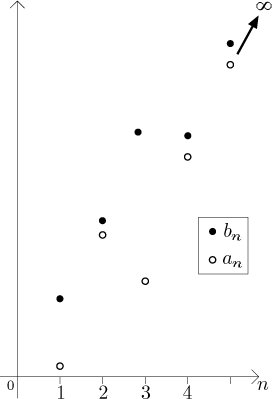
Note that if we have a comparison and one of the sequences goes to infinity,
then this situation can be used to draw some conclusion only "half the time",
if the comparison goes the right way. How is this meant? Consider for example
the situation when for all n we have the comparison
We remarked that one bound is not enough to force a convergence. Unlike the above case of improper limit, if we want to force the terms of a given sequence to go to some number, we need two bounds to restrict it from both sides, to prevent the sequence from running away up and down.
Theorem (The Squeeze theorem).
Consider three sequences{an}, {bn}, and{cn}, such that for all n we have the following:
an ≤ bn ≤ cn. If
{an} converges to some L and{cn} converges to the same L, then necessarily also{bn} converges to this L.
Why should such a theorem work? It should seem clear from the following picture:
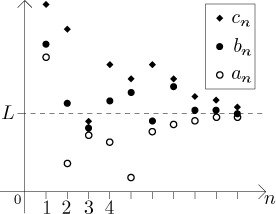
Note that "for all n" actually means "for all n used in
indexing the sequences". Since convergence is really determined by the tails
of sequences, not their beginnings, it is even enough to assume that the
inequalities are true for "n large enough", that is, there is K
so that the inequality works for all
As an application we will prove the folowing result.
Fact.
Proof: We start with the following observation. For all integers n we have
Dividing this inequality by a positive integer n yields
Thus we have the given sequence squeezed from both sides, that is, we have an upper and lower estimate. In the language of the Squeeze theorem we would denote
![]()
Since
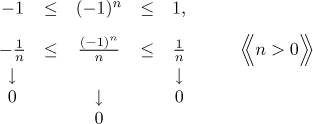
This example was typical. Expressions that oscillate often cause troubles and the usual limit finding methods fail for them, but most oscillating expressions have some natural bound, which just calls for the squeeze to be used.
Note: A proper squeeze has two parts. First, the given sequence must
be investigated to find an upper and lower estimate. Second, the upper and
lower estimate must converge to the same number. If we had only one estimate,
or if the limits of the estimates were not equal, no conclusion about the
given sequence is possible. Indeed, note that in the following pictures, the
sequence
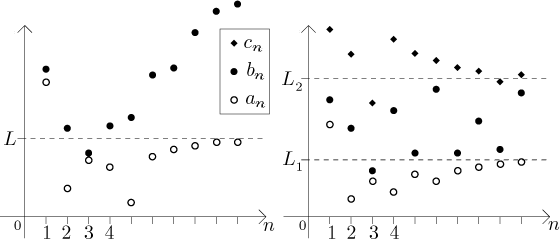
For hints on the proper use of the squeeze we refer to Methods Survey, namely the box "comparison and oscillation".
Sometimes it is more efficient to use absolute value in the squeeze, but it only works for sequences going to zero:
Theorem (The Squeeze theorem - absolute value version).
Consider sequences{an} and{bn} such that
|bn| ≤ an for all n.If
{an} converges to 0, then{bn} necessarily also converges to 0.
For instance, in the above example we could have argued as follows: For every
n we have
The Squeeze theorem has a nice consequence, a fact that is very useful when calculating limits.
Corollary.
When a bounded sequence is multiplied by a sequence that converges to zero, we get a sequence that converges to zero.
When a bounded sequence is divided by a sequence that converges to infinity, we get a sequence that converges to zero.
In short, "bounded times zero is zero" and "bounded divided by infinity is zero". This is often used.